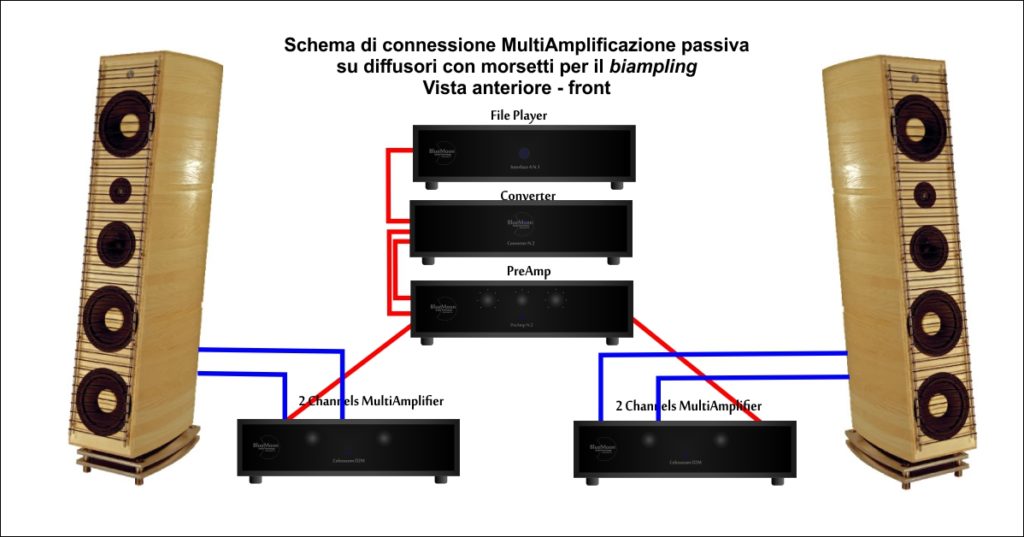How to do the “passive” MultiAmplification
For all speakers with 2 or more pairs of connection terminals
Despite the many benefits of MultiAmplification, still today it is scarcely used in HiFi systems.
The main reason for the poor diffusion of the “Passive” MultiAmplification, which is far easier to accomplish, is almost impossible to adjust independently the level of individual speakers
Indeed, by using the passive crossover inside the acoustic case, so far, no external device was allowed to adjust the level of the signal sent by the preamplifier to the amplifiers that drive the individual loudspeakers.
Today this problem is resolved, because Blue Moon has included the Colosseum D2M in its catalog, in the M series “MultiAmplification”. This component, inserted after the preamplifier, allows to adjust the level of the individual amplifiers, designed to drive the various loudspeaker ways
Let’s see how.
MultiAmplification “Horizontal”
With Blue Moon A.T.
“Multiamplification is called ‘Horizontal’ when the right and left channels of two or more stereo amplifiers drive both the right speaker and the left one”
1) “Horizontal” MultiAmplication Connection Diagram with Blue Moon A.T.
Source: Interface N.1 + Converter N.1
Preamplifier: PreAmp N.2
Power amp: No. 2 Colosseum D2M (in horizontal multi-amplification the two amplifiers must be the same)
The output signal from the preamp is sent to the left and right amplifiers (4 channels total).
Internally, the signal of each channel is simultaneously sent to the 2 amplifier modules that are separately adjustable.
Therefore, the two high and low ranges of each loudspeaker are independently editable to adjust the level of each loudspeaker, depending on the listening environment and the personal taste of the listener.
Vista posteriore dei semplici collegamenti necessari
Vertical MultiAmplification
Add one amplifier to the pre-existing stereo system
“On the other hand, it is called ‘Vertical’ when one amplifier drives the right speaker with its channels and the other amplifier drives the left speaker with its own channels. Obviously, in this case the two amplifiers must be identical, while in horizontal Multi-amplification the two amplifiers can have different brands and powers”
1) Vertical MultiAmplification connection diagram with Colosseum D2M Addition
Source: CD player
preamplifier
Amplifier: n.1 Stereo amplifier already present on the hifi system
Amplifier: n.1 amplifier Blue Moon A.T. Colosseum D2M
This is the simplest and most straightforward MultiAmplification scheme to get. In fact, the existing system will add only a Colosseum D2M stereo amplifier that has control of the output levels.
The output signal from the preamp is sent to the Colosseum D2M.
The pre-existing amplifier will amplify the high range of both speakers, while the Colosseum D2M will amplify the low range of both speakers.
Since this amplifier has separate levels for the two channels, the speaker output will be easily adjustable.
In this way, if the low range is predominant over the high range, it will be enough to lower the Colosseum D2M level to re-balance the overall emission.
If, on the contrary, the low range will be insufficient, it will be enough to increase the level of our amplifier, and again the total balance of the speakers will be restored.
Vista posteriore dei semplici collegamenti necessari
The advantages. What it improves with MultiAmplification.
- Dinamic. With the increase in total power, single amplifiers work in a much more linear range to deliver peak power, far more than their sum, reaching a very real dynamic.
- Micro contrast and increased information. When the amplifier works in a linear range, the quality and cleanness of the information passed to the speakers greatly increases. There is an amazing timbral improvement and approach to reality.
- Soundstage. More information and superior qualities improve both scenic and environmental rebuilding. Performers stand out on the stage. To make a comparison, it’s like moving from a very detailed picture to the bas-relief. Still an increase in reality
- Low frequencies. The amplifier dedicated to this band does not have to reproduce at the same time the medium and high part of the audio spectrum. This condition, coupled with increased power, produces a lower, more powerful and controlled lower extremity. Increase both the intelligibility of individual instruments working in the same frequency range as well as the control of environmental reflections.
- In other words, all of these elements approach us to reconstruct the sound event in the environment.
Well note. All this happens, provided that the two amplifiers are properly balanced. Otherwise, it would have been completely in vain, with a possible general deterioration of the listening.
We believe that with MultiAmplification can be achieved a sound reproduction level very close to that of the real event.
This is our concept of reproduction, is now easily available with BLUE MOON Audio Technology products, thanks to the M-Series amplifiers (MultiAmplifier).
Link
Interface N.1
Converter N.1
PreAmp N.2
Colosseum D2M
To hear the multi-amplification with D2 M amplifiers, you can make an appointment at :
email: sophoshiend@gmail.com
Bruno Fazzini – tel. + 39 347 1402138

Richiesta Info o appuntamento-Info request or appointment:
[contact-form-7]
Link
Interface N.1
Converter N.1
PreAmp N.2
Colosseum D2M
L'articolo Technique – How to do the passive MultiAmplification sembra essere il primo su bluemoonaudiotechnology.com.



